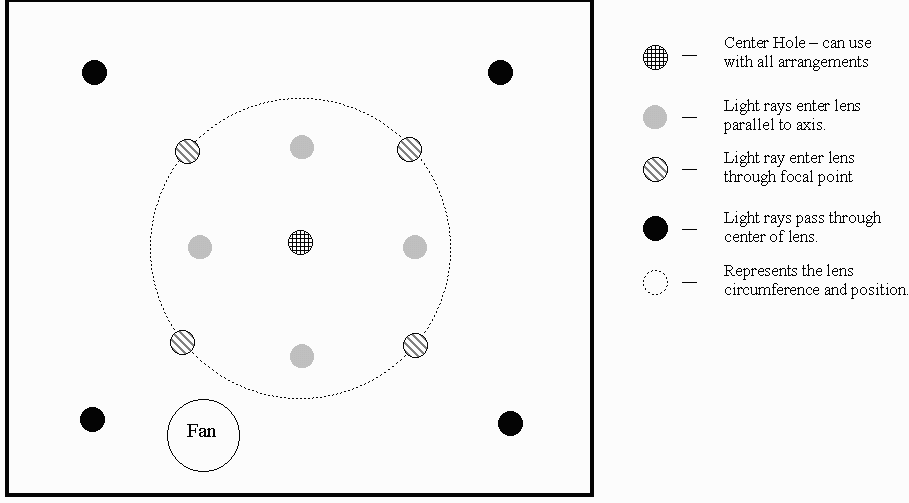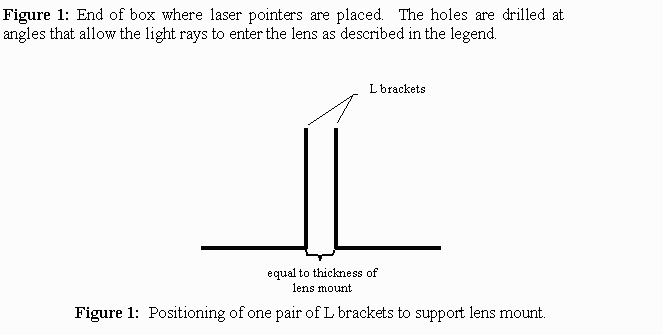



Advanced Laboratory / Lecture Demonstration Category
Apparatus Title: The Traveling Light Show
Abstract: When teaching optics and the properties of lenses we tell the students that when a ray of light enters the lens parallel to its horizontal axis it passes through the focal point on the other side and since all entering parallel rays behave this way, they all intersect at the focal point. They take our word for it, but may not be able to visualize what that means. This apparatus visually demonstrates this property as well as the properties of light rays passing through the focal point prior to entering the lens exit parallel to the axis and rays passing through the center do not change direction.
Traveling Light Show Description
When teaching optics and the properties of lenses we tell the students that when a ray of light enters the lens parallel to its horizontal axis it passes through the focal point on the other side and since all entering parallel rays behave this way, they all intersect at the focal point. They take our word for it, but may not be able to visualize what that means. This apparatus visually demonstrates this property as well as the properties of light rays passing through the focal point prior to entering the lens exit parallel to the axis and rays passing through the center do not change direction. Using laser pointers placed at appropriate angles at one end of the apparatus, light rays pass through the lens by the prescribed path and exit on the other side. The path of the lasers is shown by a fine particle material (powder, dust, etc.) inside the chambers that is circulated by a small fan mounted in each end of the apparatus. This apparatus is easily portable and lenses of various focal lengths can be used.
The apparatus is comprised of two chambers, one in which the light enters the lens and one in which light exits the lens (see Figure 1). A lens mounted between two pieces of plexiglass divides the two chambers. The length of the chambers depends upon the longest focal length lens to be used in the apparatus. The inner length of each chamber should be at least twice as long as the longest focal length lens used. The inner height and width of the chamber is determined by the diameter of the largest lens to be used. These dimensions should be approximately 10 cm greater than the diameter of the largest lens.
The end of the entrance chamber is a board or other opaque material with height and width dimension approximately 5 cm greater than the inner dimensions of the entrance chamber in both directions and is drilled with thirteen holes (see Figure 2). Five are placed within the circumference of the lens and are drilled perpendicular to the surface of the board, one in the center aligned with the center of the lens and the other four evenly spaced around the center hole. Four are evenly spaced and aligned with the circumference of the lens and are drilled at angles so that the light rays pass through the focal point prior to entering the lens. The remaining four are evenly spaced and placed outside the circumference of the lens and are drilled at angles so that the light rays pass through the center of the lens. The end of the exit chamber is a board or other opaque material of the same dimensions. A small battery operated fan is installed near the bottom of each end piece to circulate the fine particle material.
The bottom of the apparatus is also a board or other opaque material. The width of the bottom is equal to that of the ends. The bottom of the apparatus is a board that is equal in length to the two chambers added to the thickness of the lens mount described below. At the position where the lens is to be mounted, four 1 - 2 inch L brackets are positioned in pairs to provide support for the lens mount. One pair is placed back to back like bookends at each side of the board within the inner width dimension of the chamber so that the lens mount can placed between the backs of the brackets (see Figure 3).
The lens is mounted between two pieces of one-eighth inch plexiglass. Each piece of plexiglass has the same width and height as the inner dimensions of the chambers. A circular hole with a diameter that is approximately 7 mm less than the diameter of the lens to be mounted is cut in each piece of plexiglass and the lens is then placed between them and secured with bolts in each of the corners of the plexiglass.
For assembly purposes, the end pieces have one-eighth inch wide slots routed out along the two side edges so that the plexiglass sides slide into place. The bottom should also have one-eighth inch slots along the two long sides to accommodate the side pieces of plexiglass. To assemble the apparatus, begin by screwing the two end pieces to the ends of the bottom and then slide the sidepieces into place in the routed slots. Place the lens mount in position at the L brackets, put fine particle material in each chamber and then finish by putting the top piece in place and screwing in onto the end pieces.
To operate attach an o-ring on each laser pointer (to hold them in place) and place the pointers in the appropriate holes on the end piece. Turn the pointers and fans on and you should be able observe the path of the light as it travels from the pointers through the lens. A minimum of three laser pointers is necessary to achieve the desired demonstration, however as many a five can be use for each of the three scenarios. If the apparatus is to be used with more than one lens, a lens mount and end piece will need to be made for each lens.
Materials Needed: Top: 1 piece one-eighth inch plexiglass - Length: approximately four focal lengths of the longest focal length lens plus approximately 5 cm. Width: diameter of largest lens plus approximately 15 cm.
Bottom: 1 ¾ inch thick board - Length: approximately four focal lengths of the longest focal length lens. Width: same as top
Sides: 2 pieces one-eighth inch thick plexiglass - Length: approximately four focal lengths of the longest focal length lens. Height: same as inner dimensions of chamber
Ends: 2 pieces ¾ inch board - Width: diameter of largest lens plus approximately 15 cm (same as top) Height: same as inner dimension of chamber plus thickness of bottom
Also needed: 3 - 5 laser pointers 3 - 5 O-rings to fit laser pointers 4 L brackets - 1-2 inch 2 small battery operated fans screws to put together.



